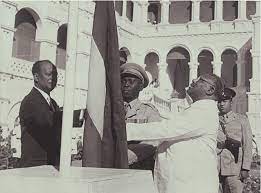This post discusses the political history of Sudan, from the early history to the independence and the politics of Sudan.
HISTORY
The history of Sudan refers to both the territory of the Republic of the Sudan, including what became in 2011 the independent state of South Sudan. The territory of Sudan is geographically part of a larger African region, also known by the term “Sudan”. or “land of the black people”, and has sometimes been used more widely referring to the Sahel belt of West and Central Africa.
The early history of the Kingdom of Kush, located along the Nile region in northern Sudan, is intertwined with the history of ancient Egypt, with which it was politically allied over several regnal eras. By virtue of its proximity to Egypt, Sudan participated in the wider history of the Near East, with the important 25th dynasty of Egypt and the Christianization of the three Nubian kingdoms Nobatia, Makuria and Alodia in the sixth century. As a result of Christianization, the Old Nubian language stands as the oldest recorded Nilo-Saharan language (earliest records dating to the eighth century in an adaptation of the Coptic alphabet).

While Islam was already present on the Sudanese Red Sea coast and the adjacent territories since the 7th century, the Nile Valley did not undergo Islamization until the 14th-15th century, following the decline of the Christian kingdoms. These kingdoms were succeeded by the Sultanate of Sennar in the early 16th century, which controlled large parts of the Nile Valley and the Eastern Desert, while the kingdoms of Darfur controlled the western part of Sudan. Two small kingdoms arose in the southern regions, the Shilluk Kingdom of 1490, and Taqali of 1750, near modern-day South Sudan, but both northern and southern regions were seized by Muhammad Ali of Egypt during the 1820s. The oppressive rule of Muhammad Ali and his immediate successors is credited for stirring up resentment against the Turco-Egyptian and British rulers and led to the establishment of the Mahdist State, founded by Muhammad Ahmad in 1881.
The modern Republic of the Sudan was formed in 1956 and inherited its boundaries from Anglo-Egyptian Sudan, established in 1899. For times predating 1899, usage of the term “Sudan” mainly applied to the Turkish Sudan and the Mahdist State, and a wider and changing territory between Egypt in the North and regions in the South adjacent to modern Uganda, Kenya and Ethiopia.
INDEPENDENT SUDAN (1956 TO PRESENT)
In February 1953, the United Kingdom and Egypt concluded an agreement providing for Sudanese self-government and self-determination. The transitional period toward independence began with the inauguration of the first parliament in 1954. On 18 August 1955 a revolt in the army in Torit Southern Sudan broke out, which although quickly suppressed, led to a low level guerrilla insurgency by former Southern rebels, and marked the beginning of the First Sudanese Civil War. On 15 December 1955 the Premier of Sudan Ismail al-Azhari announced that Sudan would unilaterally declare independence in four days’ time. On 19 December 1955 the Sudanese parliament, unilaterally and unanimously, declared Sudan’s independence. The British and Egyptian governments recognized the independence of Sudan on 1 January 1956. The United States was among the first foreign powers to recognize the new state. However, the Arab-led Khartoum government reneged on promises to southerners to create a federal system, which led to a mutiny by southern army officers that sparked seventeen years of civil war (1955–1972). In the early period of the war, hundreds of northern bureaucrats, teachers, and other officials, serving in the south were massacred. The National Unionist Party (NUP), under Prime Minister Ismail al-Azhari, dominated the first cabinet, which was soon replaced by a coalition of conservative political forces. In 1958, following a period of economic difficulties and political manoeuvring that paralysed public administration, Chief of Staff Major General Ibrahim Abboud overthrew the parliamentary regime in a bloodless coup d’état.
Read: POLITICAL HISTORY OF MOZAMBIQUE
Gen. Abboud did not carry out his promises to return Sudan to civilian government, however, and popular resentment against army rule led to a wave of riots and strikes in late October 1964 that forced the military to relinquish power.
The Abboud regime was followed by a provisional government until parliamentary elections in April 1965 led to a coalition government of the Umma and National Unionist Parties under Prime Minister Muhammad Ahmad Mahjoub. Between 1966 and 1969, Sudan had a series of governments that proved unable either to agree on a permanent constitution or to cope with problems of factionalism, economic stagnation, and ethnic dissidence. The succession of early post-independence governments was dominated by Arab Muslims who viewed Sudan as a Muslim Arab state. Indeed, the Umma/NUP proposed 1968 constitution was arguably Sudan’s first Islamic-oriented constitution.
POLITICAL HISTORY
The political system of Sudan was restructured following a military coup on 30 June 1989, when Omar al-Bashir, then a brigadier in the Sudanese Army, led a group of officers and ousted the government of Prime Minister Sadiq al-Mahdi. Under al-Bashir’s leadership, the military government suspended political parties and introduced an Islamic legal code on the national level. They then became Chairman of the Revolutionary Command Council for National Salvation (a body with legislative and executive powers for what was described as a transitional period), and assumed the posts of chief of state, prime minister, chief of the armed forces, and minister of defense. After institutionalizing Sharia law in the northern part of the country along with Hassan al-Turabi, al-Bashir issued purges and executions in the upper ranks of the army, the banning of associations, political parties, and independent newspapers and the imprisonment of leading political figures and journalists. In 1993, Sudan transformed into an Islamic totalitarian one-party state as al-Bashir abolished the Revolutionary Command Council and created the National Islamic Front (NIF) with a parliament and government obtained solely by members of NIF, and proclaimed themselves President of Sudan. As a result, the Second Sudanese Civil War with the Sudan People’s Liberation Army (SPLA) would escalate in the following years
POLITICS OF SUDAN
The politics of Sudan takes place in the framework of a federal provisional government. Previously, a president was head of state, head of government, and commander-in-chief of the Sudanese Armed Forces in a de jure multi-party system. Legislative power was officially vested in the government and in the two chambers, the National Assembly (lower) and the Council of States (higher), of the bicameral National Legislature. The judiciary is independent and obtained by the Constitutional Court. Following the Second Sudanese Civil War and the War in Darfur, Sudan was recognized as a totalitarian state where all effective political power was held by President Omar al-Bashir and their National Congress Party (NCP). Al-Bashir and NCP were ousted in a military coup which occurred on April 11, 2019. The government of Sudan was then led by the Transitional Military Council or TMC. On 20 August 2019, TMC dissolved giving its authority over to the Sovereignty Council of Sudan, who were planned to govern for 39 months until 2022, in the process of transitioning to democracy. The Sovereignty Council and the Sudanese government were dissolved in October 2021.


